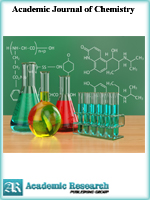Academic Journal of Chemistry
Online ISSN: 2519-7045
Print ISSN: 2521-0211
Print ISSN: 2521-0211
Quarterly Published (4 Issues Per Year)

Archives
Volume 4 Number 11 November 2019
Construction and Application of Fixed Bed, Fluidized Bed and Fluidized Drying Comprehensive Experiment
Authors: Gang Bian ; Xiuyan Pang ; Youfang Ke ; Xinyang Weng ; Yanyi Li
Pages: 118-123
DOI: doi.org/10.32861/ajc.511.118.123
Abstract
In order to establish a research-based experimental platform for students to fully mobilize initiative and learning creativity, it is necessary to establish design and exploratory experiments to highlight independent exploration and innovation. Through experimental device improvement and material screening, the three parts of fluidization curve measurement, fixed bed drying and fluidized bed drying of spherical molecular sieve are integrated into an organic entirety. Especially, the traditional basic experiment is promoted to a design and research experimental project. Results show that students experimental design ability and comprehensive quality have been improved, and it also stimulated their learning interest, cultivated the creative ability.
Improving Quality of Water from Murchison bay Using Clay from Chelel, Kapchorwa District, Uganda
Authors: Mukasa-Tebandeke I. Z. ; Karume I. ’ Wasajja H. Z. ; Nankinga R.
Pages: 102-117
DOI: doi.org/10.32861/ajc.411.102.117
Abstract
Pollution resulting from increased human activities is threatening Lake Victoria, its effects are characterized by eutrophication, high turbidity, pH, iron(II) concentration and chemical oxygen demand (COD). In this study we have investigated the effect of Fe-montmorillonite clay from Chelel on turbidity, pH, concentration of iron, total suspended soils, total nutrients and COD of water sampled from Murchison bay watershed of Nakivubo channel south of Kampala. Varying amounts of clay powder was vigorously stirred with water samples for 5 minutes, filtered using Whatman paper at ambient temperatures. The optimum concentration of clay of 0.4 gL-1 was found to produce 73.5+2% fall in COD indicating elimination of microbes and organic waste. The pH of water became 6.3+ 0.2 showing that impurities had been bound to clay. The TSS and nutrients in MB water also decreased greatly when clay was stirred with water at ambient temperatures. The available data can be relied on to recommend use of this clay in treatment of waste water and/or sewage from Kampala. Further studies on combined use of clays with alums, zeolites and/or lime need to be carried out.



